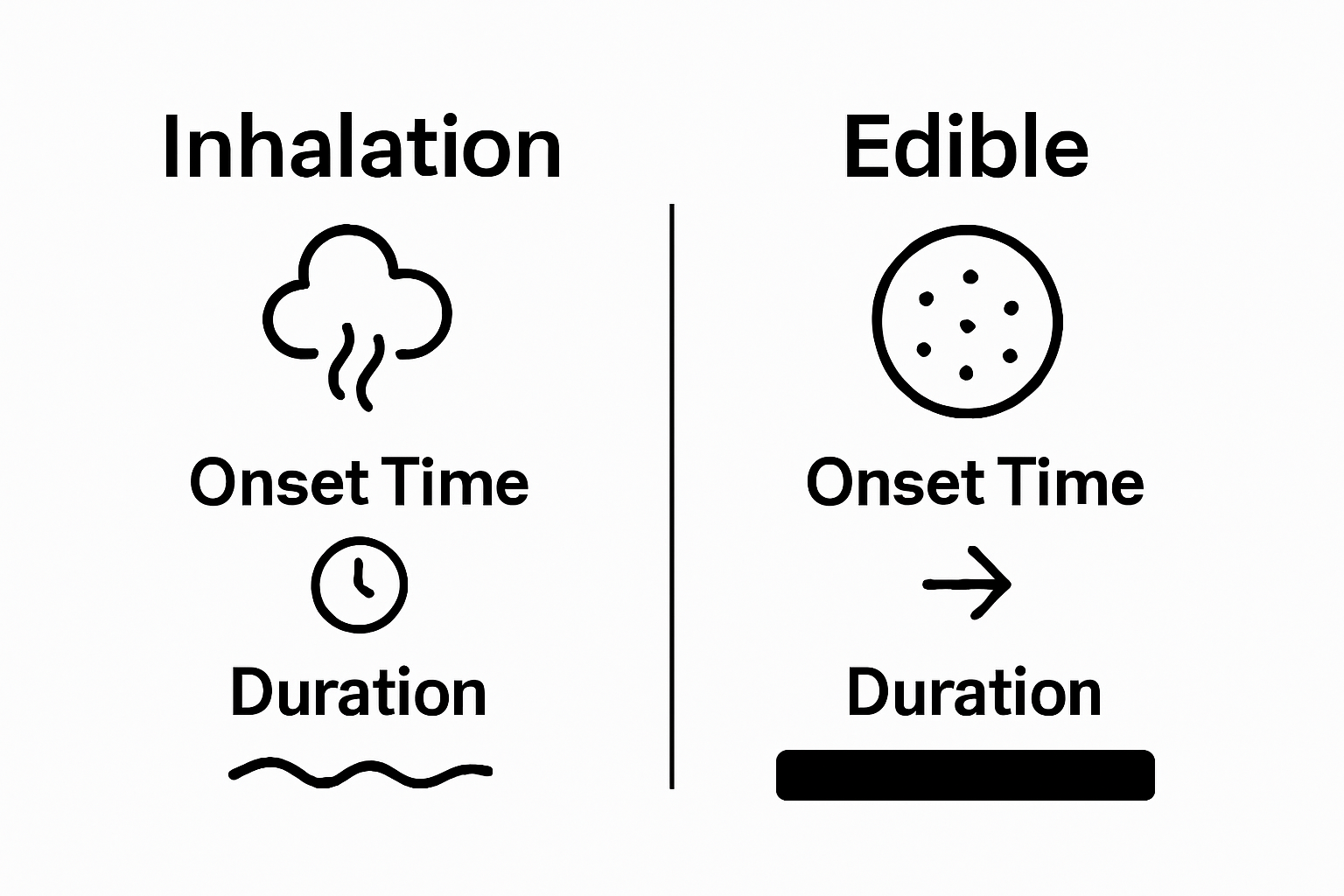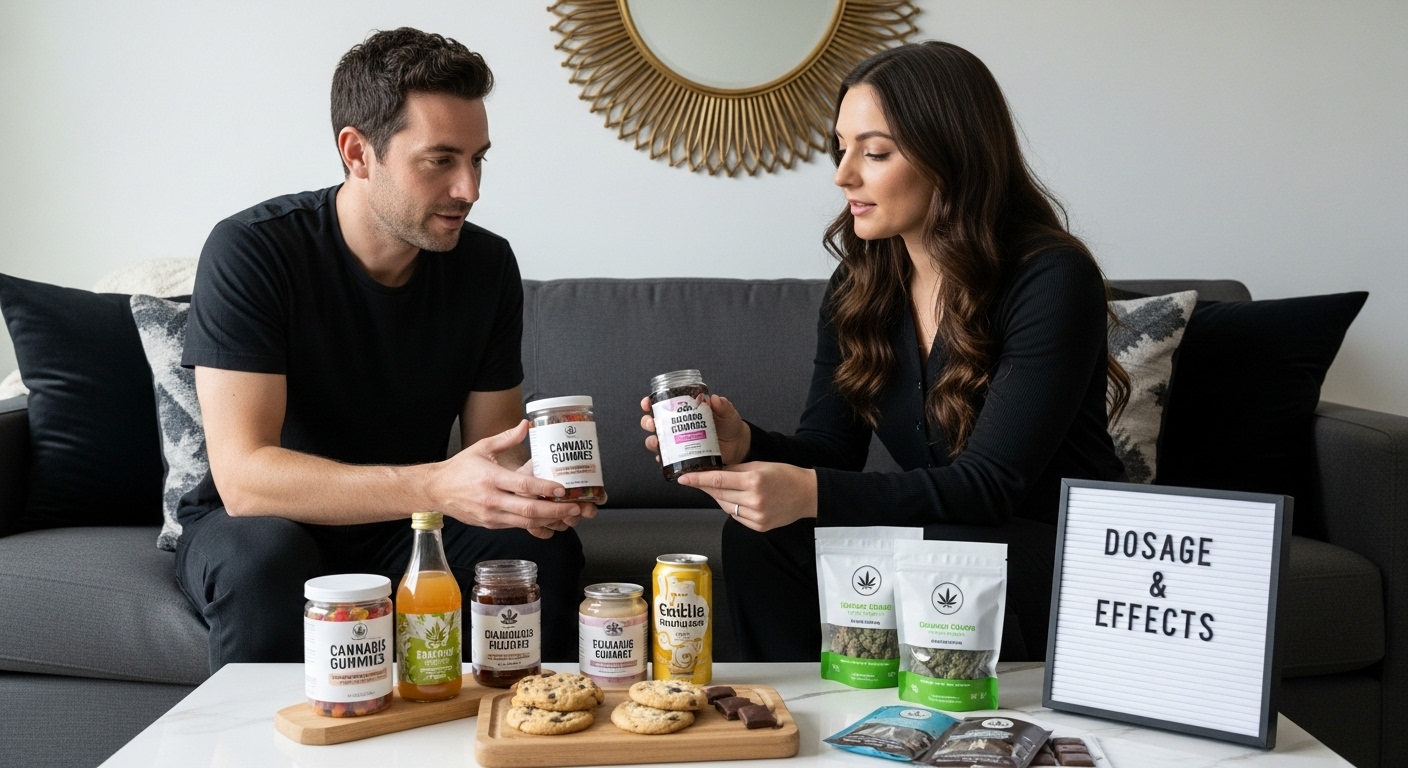Blog
Understanding Cannabis Edible Terminology Explained
People are swapping rolling joints for popping treats, and the numbers prove it. In some states cannabis edibles now make up over 40 percent of legal marijuana sales. Think that means gummies and brownies are all just about flavor? Not quite. The science and strict rules behind these tiny snacks are changing everything about who eats them, how they work, and how the law treats them.
Table of Contents
- Defining Cannabis Edibles: What Are They?
- Why Cannabis Edible Terminology Matters
- Key Terms in Cannabis Edibles: A Glossary
- The Science of Cannabinoids in Edibles
- Understanding Law and Regulations Around Edibles
Quick Summary
| Takeaway | Explanation |
|---|---|
| Cannabis edibles offer alternative consumption methods. | They are food or drink products infused with cannabinoids, unlike traditional smoking or vaping methods. |
| Onset and effects are different for edibles. | Edibles take 30-90 minutes to kick in and generally provide longer-lasting, more intense effects. |
| Clear terminology is crucial for safety. | Understanding cannabis edible terms prevents accidental consumption and supports informed decision-making for consumers. |
| Legal regulations vary by state. | Cannabis edibles are subject to different regulations across states, affecting production and consumption guidelines. |
| Accurate labeling enhances consumer awareness. | Proper labeling of THC/CBD concentrations and serving sizes ensures consumers are informed about product potency and safety. |
Defining Cannabis Edibles: What Are They?
Cannabis edibles represent a sophisticated category of cannabis consumption that transforms traditional plant compounds into consumable food and beverage products. Our comprehensive guide on cannabis gummies advantages can provide additional insights into this innovative product category.
The Basic Definition
At its core, a cannabis edible is any food or drink product infused with cannabinoids extracted from the cannabis plant. These products contain active compounds like tetrahydrocannabinol (THC) and cannabidiol (CBD), which are carefully integrated into various culinary formats. According to research from the National Institute on Drug Abuse, these products differ fundamentally from traditional cannabis consumption methods by offering an alternative ingestion pathway.
How Cannabis Edibles Work
Unlike smoking or vaping, cannabis edibles undergo a unique metabolic process in the body. When consumed, these products are processed through the digestive system, which means the cannabinoids are metabolized by the liver before entering the bloodstream. This process results in a different experience compared to other consumption methods:
The following table summarizes how cannabis edibles differ from smoking or vaping, providing a quick comparison of key characteristics.
| Feature | Edibles | Smoking/Vaping |
|---|---|---|
| Onset Time | 30-90 minutes | Seconds to minutes |
| Duration of Effects | Longer-lasting | Shorter duration |
| Effect Intensity | More intense, body-centered | Often less intense, fast peak |
| Metabolic Path | Digested, metabolized by liver | Absorbed via lungs |
| Dosage Control | Precise, labeled | Harder to measure |
| Primary Experience | Gradual, full-body effect | Quick, cerebral effect |
- Slower onset of effects (typically 30-90 minutes)
- Potentially longer-lasting impact
- More intense body-centered experience
The transformation of cannabinoids during digestion converts THC into a more potent compound, creating a distinct physiological response that many consumers find more sustained and comprehensive compared to alternative consumption methods. Cannabis edibles offer precise dosage control, making them an attractive option for individuals seeking measured and predictable cannabis experiences.

Why Cannabis Edible Terminology Matters
Understanding cannabis edible terminology is crucial for consumer safety, legal compliance, and informed decision making. Learn more about common cannabis edibles misconceptions to better navigate this complex landscape.
Consumer Safety and Awareness
Precise terminology helps prevent potential misunderstandings that could lead to unintended consumption or adverse experiences. According to research published in the Journal of Forensic Sciences, consumers unfamiliar with cannabis products may accidentally mistake edibles for regular food items, creating significant health risks.
Legal and Regulatory Implications
Cannabis edible terminology serves multiple critical functions in the regulatory environment. Clear and standardized language helps:
- Establish consistent legal definitions
- Support accurate product labeling
- Facilitate responsible marketing practices
- Enable precise medical and recreational guidelines
The use of specific, well-defined terms allows regulators, manufacturers, and consumers to communicate effectively about product characteristics, potency, ingredients, and potential effects. Accurate terminology reduces ambiguity and supports informed consumer choices in an evolving cannabis marketplace.
Health and Consumption Understanding
Comprehensive terminology provides essential context for understanding how cannabis edibles interact with the human body.
To help demystify essential cannabis edible terminology, here is a table summarizing key terms and their definitions.
| Term | Definition |
|---|---|
| THC (Tetrahydrocannabinol) | The primary psychoactive compound responsible for the “high” sensation |
| CBD (Cannabidiol) | A non-psychoactive compound known for potential therapeutic benefits |
| Full-spectrum | Products containing multiple cannabinoids, including trace amounts of THC |
| Isolate | Pure, singular cannabinoid extraction without additional compounds |
| Milligrams (mg) | Unit of measurement for cannabinoid concentration in products |
| Serving size | Recommended amount of product to consume |
| Onset time | How quickly effects are experienced after consumption, often 30-90 minutes for edibles |
| Decarboxylation | Heating cannabis to activate cannabinoids before infusion |
| Infusion | Integrating cannabinoids into food or beverage products |
| Solventless extraction | Mechanical extraction process without chemical solvents for a pure, high-quality product |
| By clearly defining terms related to dosage, onset time, duration of effects, and cannabinoid profiles, consumers can make more educated decisions about their consumption. This knowledge is particularly important given the unique metabolic process of edibles compared to other cannabis consumption methods, where effects can be more intense and longer-lasting. |

Key Terms in Cannabis Edibles: A Glossary
Our comprehensive guide to popular cannabis edibles can help supplement this terminology overview. Understanding the specialized language surrounding cannabis edibles is crucial for consumers and enthusiasts alike.
Cannabinoid Terminology
Cannabinoids represent the primary active compounds found in cannabis products. These complex molecules interact with the human endocannabinoid system, producing various physiological responses. Key cannabinoid terms include:
- THC (Tetrahydrocannabinol): The primary psychoactive compound responsible for the “high” sensation
- CBD (Cannabidiol): A non-psychoactive compound known for potential therapeutic benefits
- Full-spectrum: Products containing multiple cannabinoids, including trace amounts of THC
- Isolate: Pure, singular cannabinoid extraction without additional compounds
Dosage and Consumption Terms
Precise terminology helps consumers understand product potency and expected effects. Important dosage-related terms include milligrams (mg), which measure cannabinoid concentration, and serving size, indicating the recommended consumption amount. Onset time describes how quickly effects are experienced, typically ranging from 30 to 90 minutes for edibles.
Production and Processing Language
Cannabis edible production involves specialized terminology that reflects extraction and manufacturing processes. Decarboxylation refers to heating cannabis to activate cannabinoids, while infusion describes the method of integrating cannabinoids into food products. Solventless extraction represents a premium production technique that uses mechanical methods to preserve cannabinoid integrity without chemical solvents, ensuring a pure and high-quality final product.
The Science of Cannabinoids in Edibles
Learn more about CBD gummy consistency factors to better understand the complex scientific mechanisms behind cannabinoid interactions. Cannabinoids represent a fascinating molecular landscape with profound implications for human physiology.
Molecular Interaction Mechanisms
Cannabinoids interact with the human body through the endocannabinoid system, a complex cell-signaling network responsible for maintaining physiological homeostasis. These molecules bind primarily to two receptor types: CB1 receptors concentrated in the brain and central nervous system, and CB2 receptors predominantly located in peripheral immune cells. According to research from the National Institute on Drug Abuse, this interaction triggers a cascade of biological responses that can influence mood, pain perception, immune function, and metabolic processes.
Metabolic Transformation Process
When consumed as edibles, cannabinoids undergo a unique metabolic journey that significantly differs from other consumption methods. The digestive system metabolizes these compounds through the liver, converting delta-9-THC into 11-hydroxy-THC, a more potent metabolite with enhanced psychoactive properties. This metabolic transformation explains why edibles often produce more intense and longer-lasting effects compared to inhalation methods.
Bioavailability and Absorption Dynamics
Cannabinoid bioavailability in edibles is influenced by several critical factors:
- Individual metabolic rate
- Presence of dietary fats
- Genetic variations in enzyme production
- Specific product formulation
The absorption process is complex, with cannabinoids requiring lipid-based carriers for optimal transportation through the digestive system. This scientific understanding highlights why some individuals experience more pronounced effects than others, even when consuming identical dosages.
Understanding Law and Regulations Around Edibles
Legal landscapes surrounding cannabis edibles are complex and continuously evolving, requiring careful navigation by consumers and producers alike. Learn about common cannabis edibles misconceptions to better understand the nuanced regulatory environment.
Federal and State Legal Frameworks
Cannabis edible regulations represent a multilayered legal challenge, with significant variations between federal and state jurisdictions. According to the U.S. Food and Drug Administration, federal law currently classifies cannabis with more than 0.3% THC as a controlled substance, creating a complex regulatory landscape. State-level regulations further complicate this framework, with some states permitting recreational and medical cannabis edibles while others maintain strict prohibition.
Packaging and Labeling Requirements
Regulatory bodies have established stringent guidelines for cannabis edible packaging to ensure consumer safety and transparency. Critical requirements typically include:
- Clear THC/CBD concentration labeling
- Child-resistant packaging
- Warning statements about potential effects
- Ingredient lists and nutritional information
- Recommended serving sizes
- Potential allergen disclosures
Age Restrictions and Consumption Guidelines
Legal frameworks universally mandate strict age restrictions for cannabis edible consumption, typically setting the minimum age at 21 for recreational use. These regulations aim to prevent access by minors and establish responsible consumption protocols. Producers must implement robust verification mechanisms to prevent sales to underage individuals, including clear identification requirements and potential digital age verification systems for online purchases.
Below is a table outlining the main regulatory considerations for cannabis edibles in the United States and how they impact production and sale.
| Regulatory Aspect | Key Requirements/Considerations |
|---|---|
| Federal Legal Status | Classified as controlled if over 0.3% THC; complex legal landscape |
| State Legal Status | Varies by state: recreational, medical, or prohibited |
| Packaging/Labeling | Requires THC/CBD content, child-resistant, warnings, ingredients |
| Age Restrictions | Must be 21 or older for recreational access |
| Product Testing | Often required for potency and contaminants |
| Marketing Restrictions | Regulated to prevent targeting minors or misleading claims |
Move from Confusion to Confidence with Good Tide CBD Gummies
Decoding cannabis edible terminology can feel overwhelming, especially if you worry about proper dosage, ingredient transparency, or authenticity. The article highlighted common pain points such as confusing product labels, lack of clear cannabinoid definitions, and uncertainty about the effects of edibles. You deserve peace of mind and a safe experience. Imagine all the terms, effects, and labels explained, matched with products that deliver exactly what they promise.

Ready to shop with clarity and confidence? Visit Good Tide CBD Gummies for complete transparency. Explore our lab-tested gummies, check real customer reviews, and find detailed product descriptions that align with what you have learned. Choose premium treats made with solventless hash rosin and tropical-inspired flavors. Take the guesswork out of your next purchase and experience the true meaning of quality edibles. Discover your new favorite gummies today.
Frequently Asked Questions
What exactly are cannabis edibles?
Cannabis edibles are food and beverage products infused with cannabinoids extracted from the cannabis plant, such as THC and CBD. They provide an alternative method of consumption compared to smoking or vaping.
How do cannabis edibles differ from other forms of consumption?
Unlike smoking or vaping, cannabis edibles are metabolized through the digestive system, which leads to a slower onset of effects (typically 30-90 minutes) and often results in a more intense and longer-lasting experience.
What terminology should I know when it comes to cannabis edibles?
Key terms include THC (the psychoactive compound), CBD (a non-psychoactive compound), serving size (the recommended amount to consume), and onset time (how quickly effects are felt). Understanding these terms can help guide informed decisions about consumption.
Why is it important to understand cannabis edible terminology?
Understanding cannabis edible terminology is crucial for consumer safety, legal compliance, and informed decision-making. It helps prevent misunderstandings about product potency and effects, ensuring a safer consumption experience.
Recommended
- 7 Cannabis Edibles Misconceptions You Need to Know
- 7 Popular Examples of Cannabis Edibles You Should Try
- 7 Key Cannabis Gummies Advantages You Should Know
- Understanding CBD vs THC Gummies

